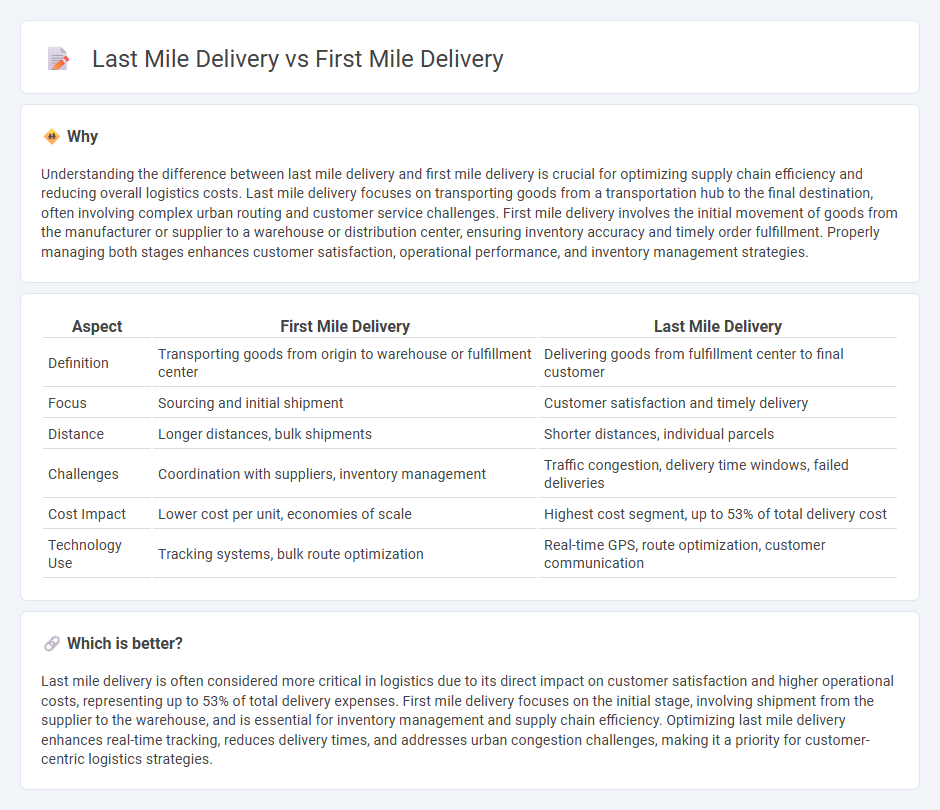
Last mile delivery focuses on transporting goods from a local distribution center to the final customer, emphasizing speed and accuracy to enhance customer satisfaction. First mile delivery involves the initial movement of products from the manufacturer or supplier to a central warehouse, highlighting bulk handling and efficient consolidation. Explore how optimizing both delivery stages can transform supply chain efficiency and reduce overall costs.
Why it is important
Understanding the difference between last mile delivery and first mile delivery is crucial for optimizing supply chain efficiency and reducing overall logistics costs. Last mile delivery focuses on transporting goods from a transportation hub to the final destination, often involving complex urban routing and customer service challenges. First mile delivery involves the initial movement of goods from the manufacturer or supplier to a warehouse or distribution center, ensuring inventory accuracy and timely order fulfillment. Properly managing both stages enhances customer satisfaction, operational performance, and inventory management strategies.
Comparison Table
| Aspect | First Mile Delivery | Last Mile Delivery |
|---|---|---|
| Definition | Transporting goods from origin to warehouse or fulfillment center | Delivering goods from fulfillment center to final customer |
| Focus | Sourcing and initial shipment | Customer satisfaction and timely delivery |
| Distance | Longer distances, bulk shipments | Shorter distances, individual parcels |
| Challenges | Coordination with suppliers, inventory management | Traffic congestion, delivery time windows, failed deliveries |
| Cost Impact | Lower cost per unit, economies of scale | Highest cost segment, up to 53% of total delivery cost |
| Technology Use | Tracking systems, bulk route optimization | Real-time GPS, route optimization, customer communication |
Which is better?
Last mile delivery is often considered more critical in logistics due to its direct impact on customer satisfaction and higher operational costs, representing up to 53% of total delivery expenses. First mile delivery focuses on the initial stage, involving shipment from the supplier to the warehouse, and is essential for inventory management and supply chain efficiency. Optimizing last mile delivery enhances real-time tracking, reduces delivery times, and addresses urban congestion challenges, making it a priority for customer-centric logistics strategies.
Connection
Last mile delivery and first mile delivery are interconnected stages within the supply chain that ensure seamless product movement from origin to end customer. Efficient first mile delivery involves the collection and initial transportation of goods from suppliers or manufacturers to distribution centers, while last mile delivery focuses on the final transfer of products from these centers to the consumer's doorstep. Optimizing both stages enhances overall logistics efficiency, reduces transit times, and improves customer satisfaction.
Key Terms
**First Mile Delivery:**
First Mile Delivery involves the initial stage of the supply chain, where goods are collected from manufacturers or suppliers and transported to distribution centers or warehouses. Efficient first mile logistics optimize inventory management, reduce transit times, and ensure seamless handoffs for downstream delivery processes. Explore key strategies and technologies driving first mile delivery optimization to enhance overall supply chain efficiency.
Origin Pickup
First mile delivery involves the initial stage of the supply chain where goods are collected from the origin point, typically a manufacturer, warehouse, or supplier, ensuring accurate inventory handling and timely dispatch. Last mile delivery focuses on the final leg of the journey, delivering products directly to the customer's doorstep, emphasizing speed and customer experience. Explore the key operational differences and strategic benefits to optimize your logistics by understanding both first mile and last mile delivery processes.
Supplier Coordination
First mile delivery requires seamless supplier coordination to ensure timely pickup and accurate order processing, which directly impacts the efficiency of the entire supply chain. Effective communication and real-time tracking between suppliers and logistics providers minimize delays and inventory mismatches. Discover more insights into optimizing supplier coordination for enhanced first mile delivery performance.
Source and External Links
First Mile Delivery & Logistics - First mile delivery is the initial supply chain stage where finished goods are picked up from the supplier or manufacturer and transported to a warehouse or distribution center, setting the foundation for the rest of the delivery process with benefits like improved inventory management and supply chain visibility.
What is first-mile delivery? How to optimize first-mile logistics to overcome its challenges - First-mile delivery involves transporting goods from a merchant's premises or warehouse to the next hub, playing a crucial role as the first step in the supply chain that directly impacts overall delivery efficiency and customer satisfaction.
Understanding First-Mile Delivery & Why it's Important for Supply Chains - First-mile delivery is the transport of inventory from a production facility to a warehouse or distribution center, often outsourced to carriers, with costs and timing dependent on distance and shipping methods chosen.
 dowidth.com
dowidth.com